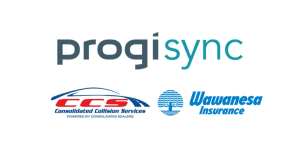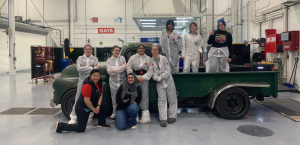By Jeff Sanford
Toronto, Ontario — April 19, 2016 — This week sees the first ever Canadian conference dedicated to automated vehicles (AVs) kicking off in downtown Toronto. Collision Repair magazine is in attendance at Automated Vehicles: Planning the Next Disruptive Technology taking place at One King West Hotel & Residence.
Automated vehicles, of course, represent a potential disruption to a lot of current business , and not just for the collision repair and auto insurance industries. As the technology for AVs emerges, the discussion around the effect this new technology will have in the years to come heats up. If the size of the crowd on hand at One King West for kick off of the conference is any indication this is an area of great and burgeoning interest. The main room of the conference was packed.
The potential that is looming for this technology to have disruptive effects was one of the themes of the event. “We hope this is a wake up call. Governments need to begin thinking about this, dealing with it and reacting,” said Julia Markovich, Research Associate with the Conference Board of Canada, opening up the conference.
She went on to note that AVs have been presented in one of two ways. One way is the “celebratory view” that is, as if this technology is going to create endless new benefits the likes of which we have not seen before. The other way that has been considered is that AVs are “inherently problematic” and will have many costs associated with their arrival. “Each of these approaches is misleading. Resist the temptation to view them as inherently bad or inherently good,” said Markovich.
In the presentations that followed, it became clear that no one is really sure yet what to expect in terms of autonomous vehicles and their arrival. The unpredictability of the outcomes is no doubt driving interest in the subject. Markovich did say it is good that so many are beginning to address the issues around AVs before they arrive. In this way she says we can avoid “another ride-sharing scenario” like Uber where a new technology arrived before anyone had to think about implementation and ended up creating real social havoc. “We don’t want another situation where we don’t know what to do,” said Markovich. “This conference is an attempt to avoid having another ride-sharing scenario.” This seems smart. The potential for real social chaos as business models across the economy are upended is real with AVs. This was clear in the next presentation of the morning.
Following Markovich was Barrie Kirk of the Canadian Automated Vehicle Centre of Excellence (CAVCOE). Collision Repair magazine has talked with Kirk in the past, and he is always one to deliver some interesting ideas about the new and weird world of AVs.
“The first message is that the first generation of AVs is here now. You can go to showrooms and buy vehicles with semi-autonomous functions like auto braking and lane change ability,” says Kirk. He went on to talk about a couple of projects in Europe where truly autonomous vehicles are already in use. “Some parts of the industry are going after low-hanging fruit. Automated busses are going into use at a French nuclear power plant. They have a fixed route and low speed. It’s a very controlled environment,” says Kirk. “But it is the use of truly automated vehicle technology.”
Some other recent examples of the arrival of true AV technology is right here in Canada. Major oilsands company Suncor has announced it is buying 175 heavy haulers to work in the tarsands. “They have demonstrated computers are better drivers than humans. About 800 people are going to lose their jobs. That’s tragic, but that’s the world to come,” says Kirk.
Going on make a prediction, Kirk says we’ll see the first fully autonomous vehicles in showrooms in 2020. “By 2025, AVs will make up a significant among of miles travelled,” he says.
The adoption of these vehicles will be driven by safety concerns. “That’s the single biggest issue here, safety. My hope is we can save 80 percent of those injuries,” says Kirk. That said, he noted that there will still be accidents even with AVs. “There is no such thing as a crashproof car. Seven percent of accidents will happen whether a computer or a human is driving,” says Kirk. He notes that Google has been smart in making expectations around AVs are not set too high by saying there will be collisions and that there will be fatalities involving driverless cars in the future. “They are setting expectations where they should be,” says Kirk. “That’s good.”
Kirk also predicted some big benefits from the adoption of AVs. “Full deployment of AVs would be a benefit of $65 billion year to the national GDP,” says Kirk. “The average family could save $3,000 a year.”
Urban areas would move away from being a crowded, noisy environment in which each resident and visitor has their own private car, to one in which automated, connected and electric cars allow vehicle sharing and other less obtrusive means to mobility.
“This allows for mobility as a service, as a personalized mass transit option. We’re seeing a trend away from personal car ownership and a merging of regular taxi, car rental and transit business models,” says Kirk.
These shifts will have a huge impact on the private sector. “The insurance industry is waking up in a big way to the fact that there business model will be broken by about 2020,” says Kirk. “Those in the parking industry will feel changes as the self-driving taxis don’t need to sit downtown. They can go out of the core and park where it’s cheaper. Unfortunately there will be jobs lost. Anyone who is involved in driving a car, their job is at risk. Even police have to think about this when you consider that over fifty percent of interaction with the police is because of driving. If, as we assume, computers will be safer and drive strictly according to law, then we can see a need for a lot fewer traffic police.”
Kirk went on to talk about a discussion he had with lawyer who specializes in collision litigation. “He was quite concerned about his business model. With fewer accidents there will be a lower need for litigation,” says Kirk.
There are few concrete answers about how AVs are going to change the world, but it does seem this technology is on its way, and we’ll provide some more insights from the rest of the conference over the days to come. Stay tuned!





































